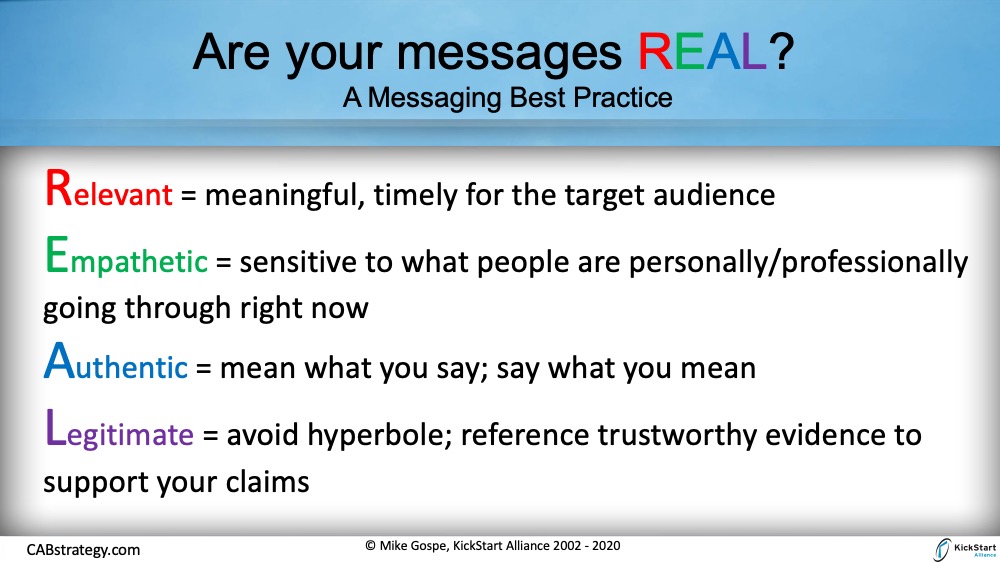On June 17, KickStart Alliance hosted a Coffee Chat on messaging best practices. Are your messages REAL? (relevant, empathetic, authentic, and legitimate)
Premise:
I offered that a month into lockdown I was receiving tone-deaf messages from some of my vendors and partners. These were not spam. But the timing and messages from these companies didn’t fit. (No, I don’t want to visit a car dealership to lease another car — during lockdown? No, I don’t need to upgrade my payroll system — now, really?) I believe I received these messages because they were automated in the company’s marketing system and nobody thought to update or remove them. With this in mind, what advice are you giving your marketing teams, or what advice is your marketing leader giving you, on messaging today? How is it different from 6 months ago?
Discussion takeaways:
Bombardment: “Today I’m getting bombarded with messages. Everyone is telling me everything they are doing to be safe. I’m tired of getting verbose explanations from every company.”
Proactive vs reactive: “In the past, our company was reactive with our messaging. Now, we are purposefully proactive. We want to provide helpful content. We strive to stay consistent with our core values.”
Less is more: “We don’t want to overload our customers. So, we’ve reduced the footprint of our content. We’re posting quick tips and inspiration quotes that are meaningful to our customers and solutions. Bite-sized bits of really helpful information.”
Every customer is unique: “We can’t treat everyone as the same. And every person may be going through something different on a personal level. We need to be more empathetic and sensitive in when and how we reach out.”
Ask customers what they want: “We’ve been using surveys to find out what (content or services) our customers really want. Then, we’ll produce that. We can no longer afford to aim the firehose at them.”
Keep it REAL: “Get rid of the fluff. The REAL format is a good guide.”
Final takeaways:
1) In my non-statistically relevant sample, I’ve asked C-suite executives how much time they are on Zoom. The minimum number is 4 hours. The average is between 7 – 8 hours per day. And everyone is very tired. This is your target audience!
2) When talking with customers, the only questions that matter are:
* How are you doing?
* How has COVID-19 affected your business?
* What can we do to help you?
Learn how to listen. One participant told me, “We discovered new business opportunities by sitting back and listening.”
3) The REAL format is a good, simple reminder for everyone, especially marketers, sales reps, and customer experience leaders.
I offer this simple slide to marketers everywhere. Print it out and let it be a reminder.
__________________
JOIN OUR JULY 1 KICKSTART COFFEE CHAT
Mike Gospe is a co-founder of KickStart Alliance, an advisory board and customer success leadership consulting team.


Trackbacks/Pingbacks